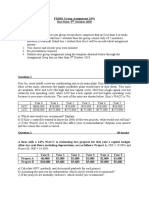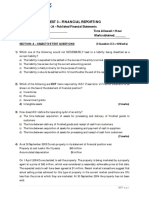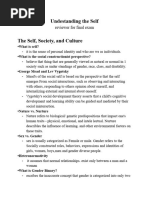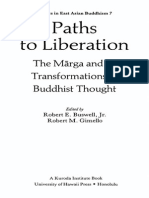0 ratings0% found this document useful (0 votes)
296 viewsChapter-3 Differences in Culture: What Is Cross-Cultural Literacy?
Chapter-3 Differences in Culture: What Is Cross-Cultural Literacy?
Uploaded by
Fariha ZahidCopyright:
© All Rights Reserved
Available Formats
Download as PPTX, PDF, TXT or read online from Scribd
Chapter-3 Differences in Culture: What Is Cross-Cultural Literacy?
Chapter-3 Differences in Culture: What Is Cross-Cultural Literacy?
Uploaded by
Fariha Zahid0 ratings0% found this document useful (0 votes)
296 views27 pagesOriginal Title
03
Copyright
© © All Rights Reserved
Available Formats
PPTX, PDF, TXT or read online from Scribd
Share this document
Did you find this document useful?
Is this content inappropriate?
Copyright:
© All Rights Reserved
Available Formats
Download as PPTX, PDF, TXT or read online from Scribd
Download as pptx, pdf, or txt
0 ratings0% found this document useful (0 votes)
296 views27 pagesChapter-3 Differences in Culture: What Is Cross-Cultural Literacy?
Chapter-3 Differences in Culture: What Is Cross-Cultural Literacy?
Uploaded by
Fariha ZahidCopyright:
© All Rights Reserved
Available Formats
Download as PPTX, PDF, TXT or read online from Scribd
Download as pptx, pdf, or txt
You are on page 1of 27
Chapter-3 Differences in Culture
What Is Cross-Cultural Literacy?
• Cross-cultural literacy is an understanding of
how cultural differences across and within
nations can affect the way in which business is
practiced
• A relationship may exist between culture and
the costs of doing business in a country or
region
Copyright © 2011 McGraw-Hill/Irwin 3-1
What Is Culture?
• Culture is a system of values and norms that are
shared among a group of people and that when
taken together constitute a design for living
where
– values are abstract ideas about what a group believes to
be good, right, and desirable
– norms are the social rules and guidelines that prescribe
appropriate behavior in particular situations
• Society refers to a group of people who share a
common set of values and norms
Copyright © 2011 McGraw-Hill/Irwin 3-2
What Are Values And Norms?
• Values provide the context within which a
society’s norms are established and justified
and form the bedrock of a culture
• Norms include
– folkways - the routine conventions of everyday life
– mores - norms that are seen as central to the
functioning of a society and to its social life
Copyright © 2011 McGraw-Hill/Irwin 3-3
How Are Culture, Society,
And The Nation-State Related?
• The relationship between a society and a
nation state is not strictly one-to-one
• Nation-states are political creations
– can contain one or more cultures
• A culture can embrace several nations
Copyright © 2011 McGraw-Hill/Irwin 3-4
What Are The
Determinants Of Culture?
• The values and norms of a culture evolve over
time
• Determinants include
– religion
– political and economic philosophies
– education
– language
– social structure
Copyright © 2011 McGraw-Hill/Irwin 3-5
What Is A Social Structure?
• Social structure refers to a society’s basic
social organization
• Consider
– the degree to which the basic unit of social
organization is the individual, as opposed to the
group
– the degree to which a society is stratified into
classes or castes
Copyright © 2011 McGraw-Hill/Irwin 3-6
How Are Individuals
And Groups Different?
• A group is an association of two or more people who have a
shared sense of identity and who interact with each other in
structured ways on the basis of a common set of expectations
about each other’s behavior
• In Western societies, there is a focus on the individual
– individual achievement is common
– dynamism of the U.S. economy
– high level of entrepreneurship
• But, creates a lack of company loyalty and failure to gain
company specific knowledge
– competition between individuals in a company instead of than team
building
– less ability to develop a strong network of contacts within a firm
Copyright © 2011 McGraw-Hill/Irwin 3-7
How Are Individuals
And Groups Different?
• In many Asian societies, the group is the
primary unit of social organization
– discourages job switching between firms
– encourages lifetime employment systems
– leads to cooperation in solving business problems
• But, might also suppress individual creativity
and initiative
Copyright © 2011 McGraw-Hill/Irwin 3-8
What Is Social Stratification?
• All societies are stratified on a hierarchical basis into social
categories, or social strata
• Must consider
1. The degree of social mobility - the extent to which individuals can
move out of the strata into which they are born
• caste system - closed system of stratification in which social position is
determined by the family into which a person is born
– change is usually not possible during an individual's lifetime
• class system - form of open social stratification
– position a person has by birth can be changed through achievement or luck
2. The significance attached to social strata in business contacts
• Class consciousness is a condition where people tend to perceive
themselves in terms of their class background, and this shapes their
relationships with others
Copyright © 2011 McGraw-Hill/Irwin 3-9
How Do Religious
And Ethical Systems Differ?
• Religion is a system of shared beliefs and rituals that are
concerned with the realm of the sacred
• Religion and ethics are often closely intertwined
• Four religions dominate society
1. Christianity
2. Islam
3. Hinduism
4. Buddhism
• Confucianism is also important in influencing behavior and
culture in many parts of Asia
• Ethical systems are a set of moral principles, or values, that
are used to guide and shape behavior
Copyright © 2011 McGraw-Hill/Irwin 3-10
What Is Christianity?
• Christianity
– the world’s largest religion
– found throughout Europe, the Americas, and
other countries settled by Europeans
– the Protestant work ethic (Max Weber, 1804)
• hard work, wealth creation, and frugality is the driving
force of capitalism
Copyright © 2011 McGraw-Hill/Irwin 3-11
What Is Islam?
• Islam
– the world’s second largest religion
– extends the underlying roots of Christianity to an all-embracing way of
life that governs one's being
– Islamic fundamentalism is associated in the Western media with
militants, terrorists, and violent upheavals, but in fact Islam teaches
peace, justice, and tolerance
– fundamentalists, who demand rigid commitment to religious beliefs
and rituals, have gained political power in many Muslim countries, and
blame the West for many social problems
– people do not own property, but only act as stewards for God
• people must take care of that which they have been entrusted with
– supportive of business, but the way business is practiced is prescribed
Copyright © 2011 McGraw-Hill/Irwin 3-12
What Is Hinduism?
• Hinduism
– practiced primarily on the Indian sub-continent
– focuses on the importance of achieving spiritual
growth and development, which may require
material and physical self-denial
– Hindus are valued by their spiritual rather than
material achievements
– promotion and adding new responsibilities may
not be important, or may be infeasible due to the
employee's caste
Copyright © 2011 McGraw-Hill/Irwin 3-13
What Is Buddhism?
• Buddhism
– has about 350 millions followers
– stresses spiritual growth and the afterlife, rather
than achievement while in this world
– does not emphasize wealth creation
– entrepreneurial behavior is not stressed
– does not support the caste system, individuals do
have some mobility and can work with individuals
from different classes
Copyright © 2011 McGraw-Hill/Irwin 3-14
What Is Confucianism?
• Confucianism
– ideology practiced mainly in China
– teaches the importance of attaining personal
salvation through right action
– high morals, ethical conduct, and loyalty to others
are stressed
– three key teachings of Confucianism - loyalty,
reciprocal obligations, and honesty - may all lead
to a lowering of the cost of doing business in
Confucian societies
Copyright © 2011 McGraw-Hill/Irwin 3-15
What Is The Role
Of Language In Culture?
• Language - the spoken and unspoken (nonverbal
communication such as facial expressions, personal space,
and hand gestures ) means of communication
• One of the defining characteristics of culture
– countries with more than one language often have more than one
culture
– English is the most widely spoken language in the world
– Chinese is the mother tongue of the largest number of people
– English is also becoming the language of international business
– knowledge of the local language is still beneficial, and in some cases,
critical for business success
– failing to understand the nonverbal cues of another culture can lead to
communication failure
Copyright © 2011 McGraw-Hill/Irwin 3-16
What Is The Role
Of Education In Culture?
• Formal education is the medium through
which individuals learn many of the language,
conceptual, and mathematical skills that are
indispensable in a modern society
– important in determining a nation’s competitive
advantage
– general education levels can be a good index for
the kinds of products that might sell in a country
Copyright © 2011 McGraw-Hill/Irwin 3-17
How Does Culture
Impact The Workplace?
• Management processes and practices must be adapted to
culturally-determined work-related values
• Geert Hofstede identified four dimensions of culture
1. Power distance - how a society deals with the fact that
people are unequal in physical and intellectual capabilities
2. Individualism versus collectivism - the relationship
between the individual and his fellows
3. Uncertainty avoidance - the extent to which different
cultures socialize their members into accepting ambiguous
situations and tolerating ambiguity
4. Masculinity versus femininity -the relationship between
gender and work roles
Copyright © 2011 McGraw-Hill/Irwin 3-18
Does Culture Change?
• Culture evolves over time
– changes in value systems can be slow and painful
for a society
• Social turmoil - an inevitable outcome of
cultural change
– as countries become economically stronger,
cultural change is particularly common
Copyright © 2011 McGraw-Hill/Irwin 3-19
What Do Cultural Differences
Mean For Managers?
1. It is important to develop cross-cultural literacy
– companies that are ill informed about the practices of
another culture are unlikely to succeed in that culture
– managers must beware of ethnocentric behavior, or a
belief in the superiority of one's own culture
2. There is a connection between culture and
national competitive advantage
– suggests which countries are likely to produce the most
viable competitors
– has implications for the choice of countries in which to
locate production facilities and do business
Copyright © 2011 McGraw-Hill/Irwin 3-20
Review Question
Abstract ideas about what a group believes to be
good, right, and desirable are called
a) norms
b) values
c) folkways
d) mores
Copyright © 2011 McGraw-Hill/Irwin 3-21
Review Question
The basic social organization of a society is its
a) culture
b) social structure
c) social strata
d) caste system
Copyright © 2011 McGraw-Hill/Irwin 3-22
Review Question
The group is the primary unit of social
organization in
a) the United States
b) Japan
c) Switzerland
d) Mexico
Copyright © 2011 McGraw-Hill/Irwin 3-23
Review Question
Which of the following is not characteristic of
individualism?
a) individual achievement
b) low managerial mobility
c) low company loyalty
d) entrepreneurial behavior
Copyright © 2011 McGraw-Hill/Irwin 3-24
Review Question
Which religion promotes the notion that a
moral force in society requires the acceptance
of certain responsibilities called dharma?
a) Islam
b) Hinduism
c) Buddhism
d) Confucianism
Copyright © 2011 McGraw-Hill/Irwin 3-25
Review Question
The most widely spoken language in the
world is
a) Spanish
b) Chinese
c) Hindi
d) English
Copyright © 2011 McGraw-Hill/Irwin 3-26
Review Question
_______ focuses on how society deals with the
fact that people are unequal in physical and
intellectual capabilities.
a) individualism versus collectivism
b) power distance
c) uncertainty avoidance
d) masculinity versus femininity
Copyright © 2011 McGraw-Hill/Irwin 3-27
You might also like
- Solution-Case StudyDocument26 pagesSolution-Case Studyzangzop5No ratings yet
- Why Ford Is Stalling in ChinaDocument2 pagesWhy Ford Is Stalling in ChinaAri Annisa NurNo ratings yet
- Working Capital Management Exercise 3Document2 pagesWorking Capital Management Exercise 3Nikki San GabrielNo ratings yet
- LopDocument3 pagesLopWidia Irma Yunita0% (2)
- Financial Management 1 5Document27 pagesFinancial Management 1 5imrickymaeberdinNo ratings yet
- Window To World History TG 6Document80 pagesWindow To World History TG 6hadiqa akbarNo ratings yet
- The - Cambridge - History - of - Music Criticism PDFDocument831 pagesThe - Cambridge - History - of - Music Criticism PDFGorkem AytimurNo ratings yet
- Kumpulan 2 - Kancil Group ProjectDocument58 pagesKumpulan 2 - Kancil Group ProjectYamunasri Mari100% (2)
- Chapter 16 - Securities Firms and Investment BanksDocument2 pagesChapter 16 - Securities Firms and Investment Banksmvlg26No ratings yet
- Anita Mills CaseDocument6 pagesAnita Mills CaseMohit KanjwaniNo ratings yet
- Advantages and Disadvantages of International TradeDocument6 pagesAdvantages and Disadvantages of International TradeTattys ParadiseNo ratings yet
- Assignment 1 - Introduction To Process CostingDocument7 pagesAssignment 1 - Introduction To Process Costingprettygurl_jenn12No ratings yet
- FIN 534 Homework Chapter 6Document3 pagesFIN 534 Homework Chapter 6Jenna KiragisNo ratings yet
- 25Document11 pages25Zaheer Ahmed SwatiNo ratings yet
- AIS 01 - Handout - 1Document7 pagesAIS 01 - Handout - 1Melchie RepospoloNo ratings yet
- CHP 3Document23 pagesCHP 3Laiba SadafNo ratings yet
- Transfer Pricing - THTDocument8 pagesTransfer Pricing - THTHÀ LƯU HOÀNG THÚYNo ratings yet
- Homework 2Document2 pagesHomework 2Jutt SmithNo ratings yet
- Interventionist TheoryDocument1 pageInterventionist TheoryHeisnam BidyaNo ratings yet
- Iba Syllabus AamdDocument6 pagesIba Syllabus AamdAshar ZiaNo ratings yet
- Comprehensive ReviewDocument30 pagesComprehensive ReviewRuby JaneNo ratings yet
- Chapter 02Document16 pagesChapter 02Prasenjit SahaNo ratings yet
- Chapte R: Short-Term Finance and PlanningDocument57 pagesChapte R: Short-Term Finance and PlanningMohammad Salim HossainNo ratings yet
- Chapter 6 CVP AnalysisDocument27 pagesChapter 6 CVP AnalysisMariel Angeli Chan100% (1)
- Chapter 6 Exercise AnswersDocument6 pagesChapter 6 Exercise AnswersLuong Hoang Vu100% (1)
- BAC 112 Final Examination With QuestionsDocument10 pagesBAC 112 Final Examination With Questionsjanus lopezNo ratings yet
- Chapter 4 - Quiz EnglishDocument2 pagesChapter 4 - Quiz EnglishFitri-ssiNo ratings yet
- CH 15 QuestionsDocument4 pagesCH 15 QuestionsHussainNo ratings yet
- A System Is A Set of Two or More Interrelated Components That Interact To Achieve A GoalDocument4 pagesA System Is A Set of Two or More Interrelated Components That Interact To Achieve A GoalFarhanChowdhuryMehdiNo ratings yet
- Management Strategic Chapter 4 Environmental ScanningDocument29 pagesManagement Strategic Chapter 4 Environmental ScanningNadya Shella MalindaNo ratings yet
- Midterm BusmathDocument4 pagesMidterm BusmathCJ WATTPADNo ratings yet
- FM101 Group Assignment QuestionDocument2 pagesFM101 Group Assignment QuestionReenal100% (1)
- Assignment 4 1 Warm-Up Exercises Chapter 15Document1 pageAssignment 4 1 Warm-Up Exercises Chapter 15Nafis Hasan0% (1)
- Subject: ED 801 Statistics II: Ratio Level of MeasurementDocument4 pagesSubject: ED 801 Statistics II: Ratio Level of Measurementgmarico5176No ratings yet
- RMDocument6 pagesRMAyla ShahoorNo ratings yet
- Advanced Taxation Novmock2019 PDFDocument13 pagesAdvanced Taxation Novmock2019 PDFAndy AsanteNo ratings yet
- Business Law QuizDocument2 pagesBusiness Law QuizDaniyal AliNo ratings yet
- Chapter 2-Exercises-Managerial AccountingDocument7 pagesChapter 2-Exercises-Managerial AccountingSheila Mae LiraNo ratings yet
- Performance Evaluation and Ratio Analysis - Meghna Cement - R1Document11 pagesPerformance Evaluation and Ratio Analysis - Meghna Cement - R1Sayed Abu Sufyan100% (2)
- The Regulatory Approach To The Formulation of AnDocument16 pagesThe Regulatory Approach To The Formulation of AnGanzar SvtaNo ratings yet
- CHP 15 Fin 13Document14 pagesCHP 15 Fin 13Player OneNo ratings yet
- Interest Rates Determination 3Document38 pagesInterest Rates Determination 3kafi100% (1)
- Question 2: Ias 19 Employee Benefits: Page 1 of 2Document2 pagesQuestion 2: Ias 19 Employee Benefits: Page 1 of 2paul sagudaNo ratings yet
- Chapter 14 - Provisions, Contingent Liabilities and Contingent AssetsDocument38 pagesChapter 14 - Provisions, Contingent Liabilities and Contingent AssetsamiteshNo ratings yet
- ACCT 505 Managerial Accounting - DevryDocument4 pagesACCT 505 Managerial Accounting - Devrychana980100% (5)
- Case Study: Mercantilism: Older Than Smith-And Alive TodayDocument1 pageCase Study: Mercantilism: Older Than Smith-And Alive TodayDiệu LinhNo ratings yet
- 1) Executive SummaryDocument8 pages1) Executive Summarydua fatimaNo ratings yet
- Quiz 7Document38 pagesQuiz 7nikhil gangwarNo ratings yet
- FA - PartnershipDocument109 pagesFA - PartnershipRafay RashidNo ratings yet
- Adjusting Entries Part 1Document3 pagesAdjusting Entries Part 1Jacob BabaranNo ratings yet
- ASSIGNMENT102Document30 pagesASSIGNMENT102Iisha karmela AldayNo ratings yet
- Exam On Strategic ManagementDocument11 pagesExam On Strategic Managementeulhiemae arongNo ratings yet
- Cavusgil Ib5 PPT 02-20190917112345Document41 pagesCavusgil Ib5 PPT 02-20190917112345NUR AFRINA BINTI ABASNo ratings yet
- CHAPTER 7: The Balanced Scorecard: A Tool To Implement Strategy The Balanced Scorecard Features of A Good Balanced ScorecardDocument2 pagesCHAPTER 7: The Balanced Scorecard: A Tool To Implement Strategy The Balanced Scorecard Features of A Good Balanced ScorecardPhia Teo100% (1)
- Adoption Status of BFRS, BAS, BSADocument7 pagesAdoption Status of BFRS, BAS, BSAAl RajeeNo ratings yet
- 07 Cafmst14 - CH - 05Document52 pages07 Cafmst14 - CH - 05Mahabub AlamNo ratings yet
- Project Management-An Integrated ApproachDocument3 pagesProject Management-An Integrated Approachutcm77No ratings yet
- Chapter 4 Social Systems and Organizational StructureDocument2 pagesChapter 4 Social Systems and Organizational StructureAngelo Molina100% (1)
- FIM CH 03 Non-Depository Financial InstitutionsDocument30 pagesFIM CH 03 Non-Depository Financial InstitutionsMarina KhanNo ratings yet
- Test 3 - Chap 24Document7 pagesTest 3 - Chap 24Bhushan Sawant100% (1)
- Chap 3 - IBDocument25 pagesChap 3 - IBkamaruljamil4No ratings yet
- Differences in CultureDocument30 pagesDifferences in CultureMicol VillaflorNo ratings yet
- Hwang Beyond BirthDocument13 pagesHwang Beyond BirthNiaNo ratings yet
- University of Saint Anthony Iriga City College of Business Education Midterm Activity Bapce 2Document2 pagesUniversity of Saint Anthony Iriga City College of Business Education Midterm Activity Bapce 2hazel cervantesNo ratings yet
- The Western and Eastern Concepts of SelfDocument37 pagesThe Western and Eastern Concepts of SelfElleNo ratings yet
- GE 1 ReviewrDocument18 pagesGE 1 ReviewrTrimex TrimexNo ratings yet
- Positive PsychologyDocument35 pagesPositive PsychologyRRCaratNo ratings yet
- ABriefStudyOfComparativeReligions CantrellDocument35 pagesABriefStudyOfComparativeReligions CantrellYashu YashNo ratings yet
- HUMSS - Introduction To World Religions & Belief Systems CGDocument12 pagesHUMSS - Introduction To World Religions & Belief Systems CGFlorina Nadorra Ramos100% (1)
- Global Reciprocal Colleges: EthicsDocument12 pagesGlobal Reciprocal Colleges: Ethicssharielles /No ratings yet
- Confucianism and The Law: M. Rhee Waseda UniversityDocument90 pagesConfucianism and The Law: M. Rhee Waseda UniversityLIU DANNo ratings yet
- First Quarterly Examination For English 8: Department of Education Division of Davao Del NorteDocument2 pagesFirst Quarterly Examination For English 8: Department of Education Division of Davao Del NorteMikko GomezNo ratings yet
- Human Rights and Asian Values PDFDocument10 pagesHuman Rights and Asian Values PDFJudy Chang0% (1)
- Ben-Ami Scharfstein-A Comparative History of World Philosophy From The Upanishads To Kant-State University of New York Press (1998)Document763 pagesBen-Ami Scharfstein-A Comparative History of World Philosophy From The Upanishads To Kant-State University of New York Press (1998)yishaispNo ratings yet
- Parenting and Child Socialization in Contemporary China: January 2012Document11 pagesParenting and Child Socialization in Contemporary China: January 2012yassviniNo ratings yet
- 15 Korea IntroductionDocument20 pages15 Korea IntroductionZinthya KntrzNo ratings yet
- Sociology of Religion DissertationDocument5 pagesSociology of Religion DissertationWebsitesThatWritePapersForYouSingapore100% (2)
- Jin Dan of The Wu Liu PaiDocument309 pagesJin Dan of The Wu Liu PaiBarryNo ratings yet
- Professional Education - Drill 11 - Part 4Document5 pagesProfessional Education - Drill 11 - Part 4Xindy LopezNo ratings yet
- Confucianism PPT 13Document11 pagesConfucianism PPT 13Karizma Joy Arrocena Sagsagat100% (1)
- PhilosophyDocument3 pagesPhilosophyGenesis VegaNo ratings yet
- Liway D. Delfin: Bse-English IiiDocument19 pagesLiway D. Delfin: Bse-English IiiRichmond Bautista VillasisNo ratings yet
- English 7: Express One's Beliefs/Convictions Based On A Material ViewedDocument3 pagesEnglish 7: Express One's Beliefs/Convictions Based On A Material ViewedMarjun CasasNo ratings yet
- An East and West Debate On Human RightsDocument213 pagesAn East and West Debate On Human RightsajmalshahbazNo ratings yet
- George Basalla The Spread of Western ScienceDocument17 pagesGeorge Basalla The Spread of Western ScienceAram Zaldivar RodriguezNo ratings yet
- Humss 111 Second Quarter Exam 2Document31 pagesHumss 111 Second Quarter Exam 2John Harold Astronomo0% (1)
- Undestanding The Self: Reviewer For Final ExamDocument10 pagesUndestanding The Self: Reviewer For Final Examfritzcastillo026No ratings yet
- The Guild System of EducationDocument41 pagesThe Guild System of EducationSheralyn ReyesNo ratings yet
- Paths To Liberation PDFDocument221 pagesPaths To Liberation PDFM K MishraNo ratings yet
- Chineseliterature 170211020717 PDFDocument29 pagesChineseliterature 170211020717 PDFWhITe GaRNo ratings yet

























































































